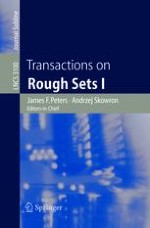2004 | Book
Transactions on Rough Sets I
James F. Peters - Andrzej Skowron, Editors-in-Chief
Editors: James F. Peters, Andrzej Skowron, Jerzy W. Grzymała-Busse, Bożena Kostek, Roman W. Świniarski, Marcin S. Szczuka
Publisher: Springer Berlin Heidelberg
Book Series : Lecture Notes in Computer Science
Included in: Professional Book Archive
